Responsible Decision-Making
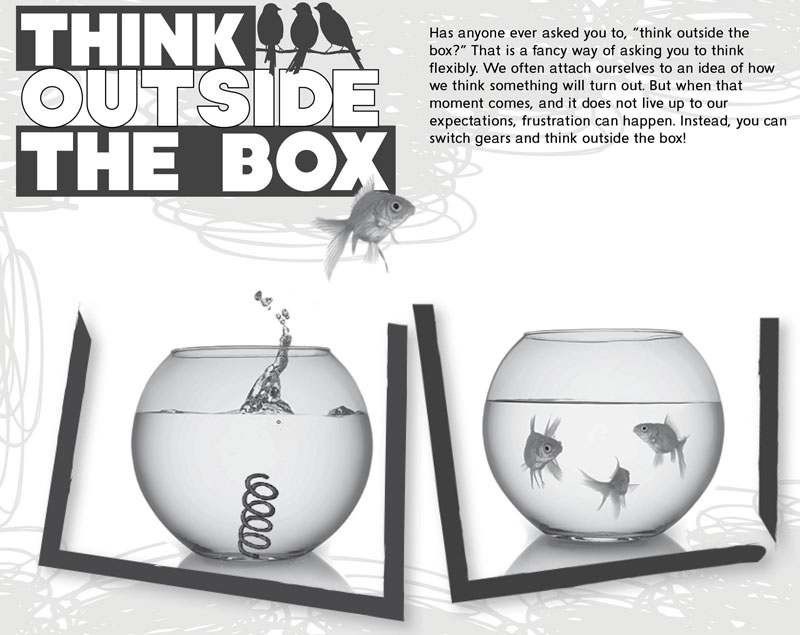
Find this activity in the student portfolio
Objective: Students will demonstrate open-mindedness and think outside the box.
Estimated Duration: 20-25 minutes
Description: Having an open mind or thinking flexibly is an important skill students need to manage their thoughts, feelings, and actions. Flexible thinking allows students to switch gears and look at things differently and allows them to unlearn old ways of doing things. Being open minded and thinking outside the box gives students the ability to embrace different points of view and listen to and consider other perspectives before making a decision. It also allows them to broaden their mind and challenge their thinking. Thinking outside the box helps during failures and can lead to deeper understandings and new beginnings.
This activity will get students to really think outside the box. They are asked to complete the beginning of drawing. The drawing could be anything they imagine it to be! If there is time, students can compare drawings to see how many different versions they came up with.
Teachable Moments: To help students have an open-mind and think flexibly:
- Change your daily routine in the classroom. Make a small tweak here and there occasionally to show students that it is okay to do things differently sometimes.
- Read a joke book with your class. Rigid thinkers tend to have a hard time understanding jokes. They also have a hard time making up their own jokes. Joke books are a good way to talk about the different meanings of words and to think about changing the meaning of a word to make it funny.
- Share ways that you have been adaptable as a teacher or even outside of the classroom. Students will learn that having the ability to adapt is normal and then they will begin to emulate this.
- Provide ample time for students to solve problems or complete projects creatively. It takes time to think differently and outside of the box.
- Ask open-ended questions, such as “What would you do next?”, “What can you do differently?” and “How can you fix this?”
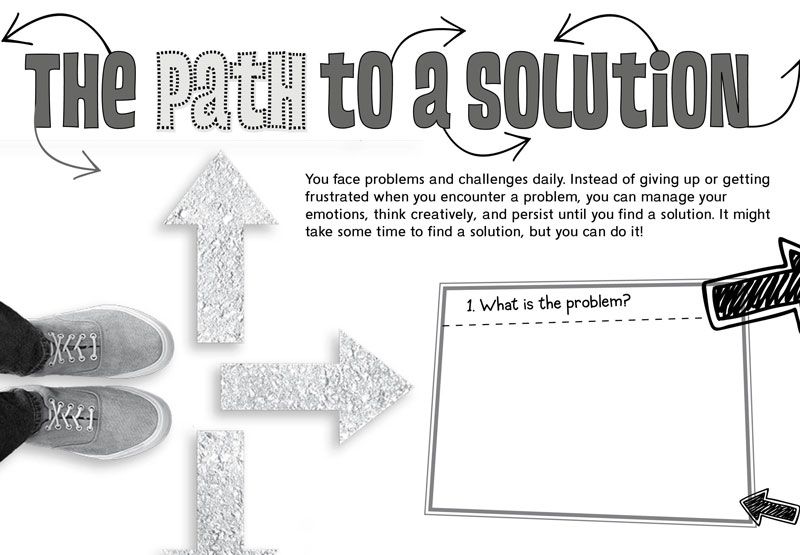
Find this activity in the student portfolio
Objective: Students will identify solutions for problems.
Estimated Duration: 20 minutes
Description: Whether it is in school, on the playground, or at home, students of all ages will face problems daily.
Most of the time, the problems are complex, not well defined, and lack a clear solution or approach. Therefore, it is important for students to identify and apply strategies to solve these problems.
This way students can become confident and independent in their problem-solving abilities. Students with problem-solving skills manage their emotions and persist until they find a solution instead of giving up or getting frustrated when they encounter a challenge.
This activity will have students think of a problem that they currently have or have had in the past. They are asked to follow a path of steps to a solution. They will be able to use these steps when future problems arise to find a solution.
Teachable Moments: To help students with problem solving:
- Look for chances to share problems and highlight ways that students worked through the problems to a solution.
- Ask open-ended questions, such as “What would you do next?”, “What can you do differently?” and “How can you fix this?”
- Provide time during class so students can practice using their problem-solving skills and strategies.
- Help students accept challenge and failure as a chance to grow and do better.
- Don’t solve the problems that arise in the classroom; be there to support and facilitate the path to a solution.
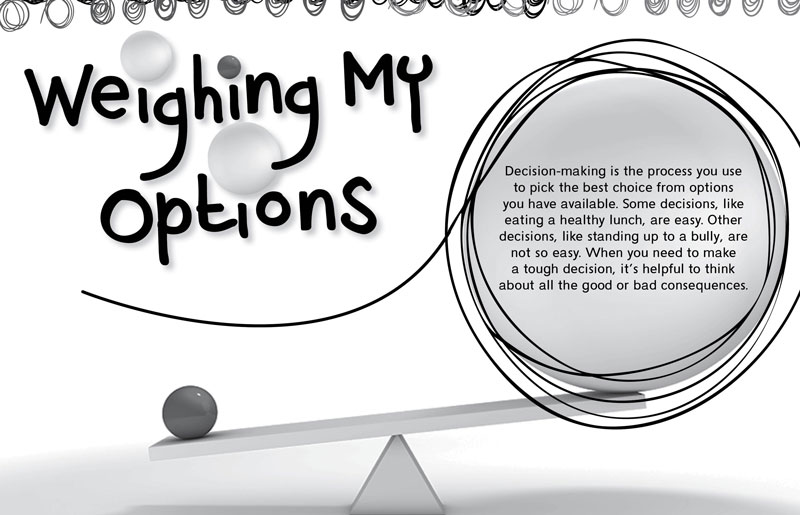
Find this activity in the student portfolio
Objective: Students will be able to understand how to make responsible decisions.
Estimated Duration: 20 minutes
Description: Decision-making is not always easy, especially when tough choices need to be made. One way to help students make choices that are good for themselves as well as good for others, is to have them weigh their options.
Asking students to take the time to evaluate and think critically about their options can help them to make responsible decisions they can feel good about.
This activity will have students think of a tough choice they have to make. They will complete a pro and con list to help them make a final decision.
Teachable Moments: There are many ways you can help students make good decisions:
- Introduce social and ethical dilemmas to students in a game of “Would you rather?” Have students share their choice and why they made it. Allow students to change their decisions, switch sides, and provide their rationale.
- Use decision trees (graphic organizer) to have teams of students work through real-life challenging scenarios.
- Try to avoid rescuing students. Let them make mistakes. Help them work through new choices and lessons learned.
- Encourage open-mindedness. Give students time to ask questions and talk to others about their opinions. Making fully educated decisions means being open to hearing and exploring all sides before making a final determination.
- Promote mindfulness by reminding students to slow down and take time to think. Filtering out the noise and reflecting on the situation is sometimes helpful when trying to make a decision.
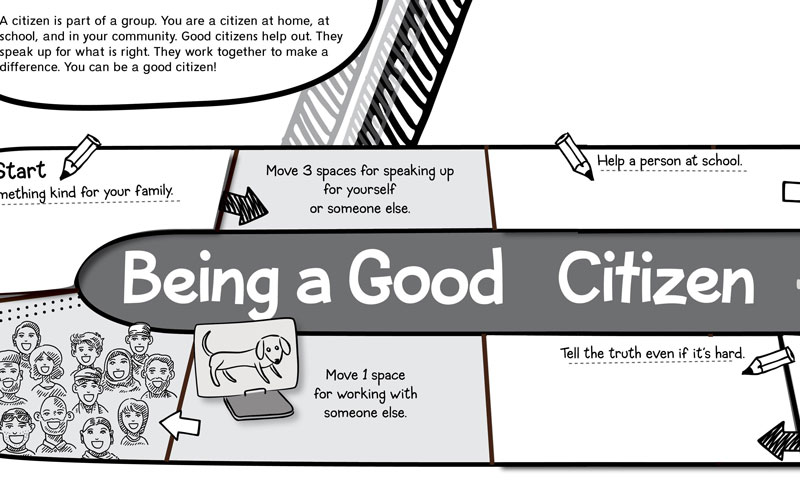
Find this activity in the student portfolio
Objective: Students will be able to demonstrate ways to be a good citizen at home, at school, and in their community.
Estimated Duration: 20 minutes
Description: Being a citizen means being a member of and supporting one’s community. For students at this age, it means working together, helping, and speaking up at home, at school, and in their community. Citizenship is important for developing a strong moral code in individuals, but it is also important for creating a safe, supportive society.
Being a citizen does not automatically make you a good citizen, which is why teaching citizenship to students is so important. By teaching children about citizenship, you can help them learn how to positively contribute at home, at school, and in their community.
This activity will allow students to play a game where they record good acts of citizenship. They will move spaces on a board and complete tasks to become a good citizen.
Teachable Moments: There are many ways you can help students to be a good citizen:
- Read books about good citizenship that promote conversations about honesty, making change, and doing one’s part.
- Give students responsibilities.
- Encourage students to join the student council or participate in classroom meetings.
- Create classroom rules together. Discuss the importance of each one and have students define consequences if they are broken.
- Remind students about the importance of being respectful, honest, compassionate, and responsible.
- Organize volunteer activities at school and in the community.
Foldable®: If...Then Moments
Estimated Duration: 25-30 minutes
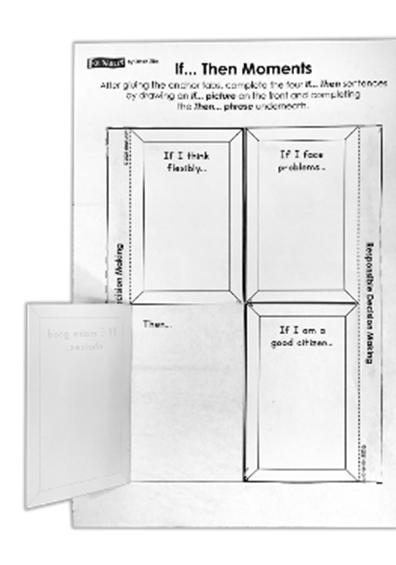
- Cut along the dark outside black lines to make one large rectangle.
- Cut along the center black line to make two long, thin rectangular sections.
- Fold along the dotted line on each section to form anchor tabs – one to the left and one to the right.
- Glue the anchor tabs onto the gray sections of the student book. Allow the glue to dry for a minute and then cut the middle black line on each side. This will make four tabs with picture frames and titles on the front of each.
- Review how each of these relates to responsible decision making—being flexible, making good choices, facing problems, and being a good citizen.
- Have students draw or write under the tabs to complete If…then sentences.
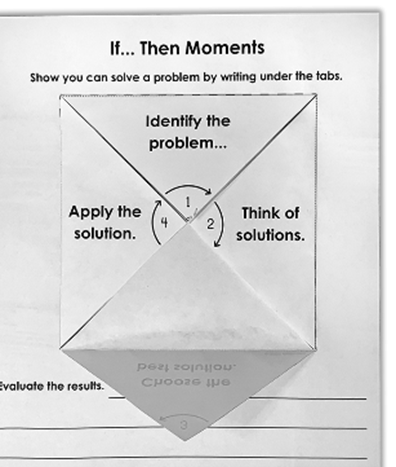
- Cut along the outside solid black lines of the square Responsible Decision Making Foldable.
- Fold along the four dotted lines in the middle of the Foldable. Always fold so the dots are visible along the fold line. Students might help each other fold. Folding will form a square with four triangular tabs.
- Glue the back of the Envelope Foldable onto the large gray square in the student book. Look at the gray section to see how to glue the square. Section #1 should be at the top of the page.
- Students will demonstrate how they use the Problem-Solving process under the tabs. Tabs make student writing private. They will identify a problem and work through the process. This may take course over varying periods of time. When they have finished the process, have students evaluate their results. Would they change anything? Remind students that improving decision making skills is a life-long process.
Go to other SEL competencies in this book (Intermediate - Grades 3–4):
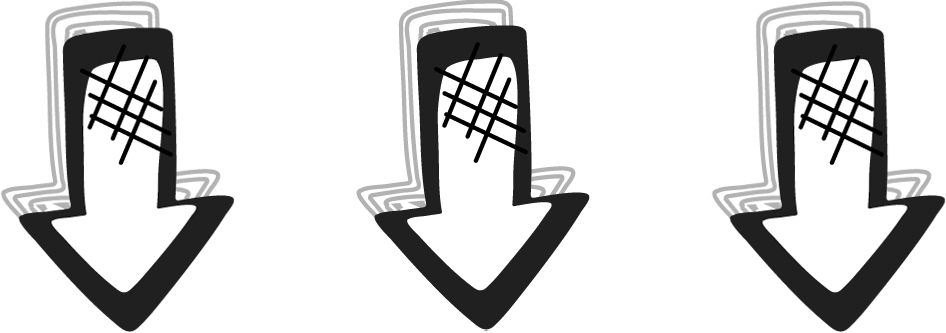
The teaching suggestions only work in accompaniment with the student portfolio, which has all the activity pages.
The teaching suggestions here are also available within a PDF of the entire teacher's manual.